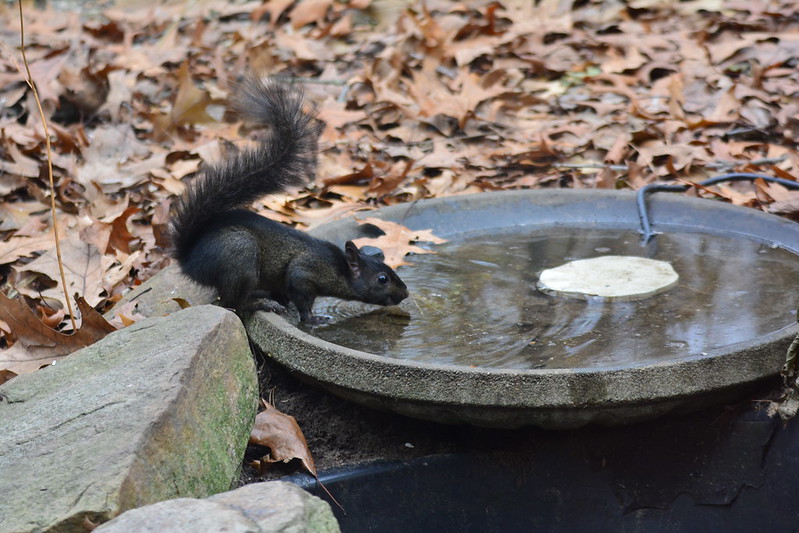Melanistic gray squirrel
December 8, 2019, at Indiana Dunes State Park Nature Center

While at the Indiana Dunes State Park Nature Center watching birds and gray and red squirrels (no chipmunks this time), I noticed a melanistic gray squirrel coming in. In all my years in Hyde Park (40!!! Eek!), I’ve seen only one, in Jackson Park between 56th and 57th Streets. On a visit to my late aunt in NW Washington, D.C., I’d seen several in the neighborhood. According to Wikipedia, there’s a reason for that:
Eighteen Canadian black squirrels were released at the National Zoo in Washington, D.C., near the beginning of the 20th century during President Theodore Roosevelt’s administration. Since their introduction, the population of black squirrels in and near Washington has slowly but steadily increased, and black squirrels now account for up to half of the squirrel population in certain locations, such as the grounds of the Washington National Cathedral.
Wikipedia mentions them in the Quad Cities area of Illinois:
Black squirrels are well established in the Quad Cities area along the Iowa-Illinois boundary. According to one story, recounted in the book The Palmers, they were first introduced on the Rock Island Arsenal Island. Some of them then escaped by jumping across ice floes on the Mississippi River when it was frozen, and thus populated other areas in Rock Island.
I hadn’t seen one at Indiana Dunes or Indiana before. This one looked lighter and more grizzled than other melanistic gray squirrels I’ve seen pictured, so it may have had one copy of a mutant gene vs. two.
Gray squirrels have two copies of a normal pigment gene and black squirrels have either one or two copies of a mutant pigment gene. If a black squirrel has two copies of the mutant gene it will be jet black. If it has one copy of a mutant gene and one normal gene it will be brown-black. In areas with high concentrations of black squirrels, litters of mixed-color individuals are common.
To me, this is the most interesting part of the Wikipedia entry:
The black subgroup seems to have been predominant throughout North America prior to the arrival of Europeans in the 16th century, when America’s old growth forests were still abundant and thick. The black squirrel’s dark color helped with better concealment from its natural predators (owls and hawks) in these very dense and shaded old growth forests. As time passed, extensive deforestation and the hunting of squirrels for their meat and pelts led to biological advantages for gray colored individuals; their light-gray color became advantageous in their newly changed habitat. Today, the black subgroup is particularly abundant in the northern part of the eastern gray squirrel’s range. This is due to two main factors. Firstly, black squirrels have a considerably higher cold tolerance than that of gray squirrels. Secondly, because the northern forests are denser and thus darker, the black squirrel enjoys the advantage of better concealment when viewed from above within this dimly lit habitat.
And after a healthy meal of seeds, it returned to the Indiana Dunes woods whence it came.




They’re very common in our area (New York City suburbs); in fact we have them at our bird feeders almost every day. They make a nice change from all the drab gray ones.
The Village Voice has an interesting article about melanistic gray squirrels in different parts of New York City. The writer finds them attractive too. https://www.villagevoice.com/2015/01/16/meet-the-mutant-squirrels-of-city-hall-park/